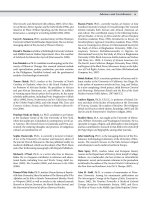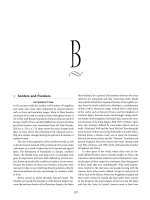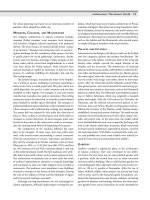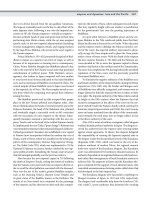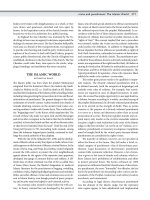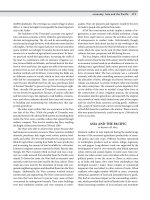Encyclopedia of society and culture in the medieval world (4 volume set) ( facts on file library of world history ) ( PDFDrive ) 862
Bạn đang xem bản rút gọn của tài liệu. Xem và tải ngay bản đầy đủ của tài liệu tại đây (82.08 KB, 1 trang )
religion and cosmology: Asia and the Pacific 835
ences. Agricultural cults that had developed from earliest
times assigned a special role to the spirits of the soil, plants,
and weather as well as local guardian spirits associated with
sacred rocks, trees, or sources of water. Local agricultural
productivity was believed to result from a partnership between humanity and the spiritual forces of the natural realm.
Ancestor cults honored the spirits of deceased relatives who
occupied a parallel realm to that of humans.
Animists believed that spirits could flow from one realm
of existence to another in ways that humans could not. Humanity occupied a middle realm, while below the earth were
domains of both benevolent fertility spirits and dangerous
forces of evil. Although the negative forces could never be
eliminated, animistic rituals tried to neutralize their ability
to do harm. In contrast, generally positive forces occupied the
celestial realms above earth and needed to be acknowledged
in rituals to encourage their favor.
A chief or priest served as the intermediary between the
earth deity and ancestors, on the one hand, and the human
community on the other. This intermediary performed rituals, sacrificial offerings of food, animals, and at times even
humans (slaves or war captives) to assure the fertility of livestock and crops and the general good fortune of the community. Prosperity was not seen as the product of human labor,
but as the work of the gods. Economic productivity was the
consequence of healthy relationships between human producers and supernatural forces.
In Japan the belief system known as Shinto united the local cults and their spirits into a hierarchical order with a single deity at the top, the sun goddess. In China the realm of the
natural spirits was the basis of Daoism, and ancestral spirit
worship was embraced by Confucianism. East Asian Confucian states such as China, Korea, and Vietnam promoted
the cult of the Mandate of Heaven, which made the emperor
the supreme intermediary between the ancestral divine and
humanity. However, local folk religions remained potent
despite official sanctions and attempts to consolidate local
deities into a state-approved religion. China’s urban leaders
dismissed folk religion as the superstition of the countryside,
but they incorporated local guardian deities into their dynastic rituals as subordinates to the celestial divine worshiped by
China’s emperors.
In India medieval-era Hinduism continued to evolve
as a blend of preexisting local animistic worship of female
fertility spirits with Vedic religious tradition that focused on
the spiritual realm of the male ancestors and was favored by
northern India’s ruling elites. (The word Vedic comes from
the Vedas, which were stories, poems, and proverbs transmitted orally for a thousand or more years before being written
down in the 300s b.c.e.) The stone linga, or male phallus, was
Vishnu with consorts; stone, India, Pala or Sena Dynasty, 12th
century (Freer Gallery of Art, Smithsonian Institution, Purchase, F1927-7)
portrayed united with the female vulva as the object of ritual
celebrations in animistic India. It was equivalent to a post,
tree, or stone in which the earth deity and ancestors were believed to materialize. Medieval-era Hinduism universalized
these local divinities, as the linga became symbolic of the deity Siva, whose specialty was assuring agricultural fertility
and human health.

